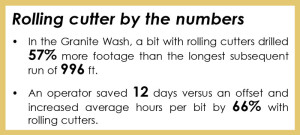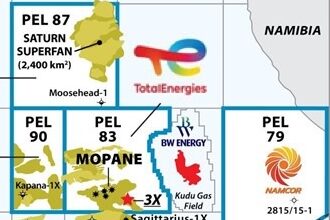Rolling PDC cutter enhances drill bit life in Granite Wash runs
360° rotation consistently presents edge to formation, distributes wear evenly and dissipates frictional heat

Courtesy of Schlumberger
By Robert Ford, Smith Bits, a Schlumberger company
Recent advances in diamond bonding techniques and manufacturing processes have enabled the industry to produce highly abrasion-resistant polycrystalline diamond cutters (PDC) for use in drill bits. The resulting increase in bit durability has enabled operators to use fixed cutter bits in harder and more abrasive formations. The increased drilling efficiency gives PDC bits an advantage over other bit types in the majority of today’s applications. However, when a PDC shearing element is welded into the bit body, it becomes fixed, and only a small portion of the cutter’s edge will contact the rock as the bit rotates downhole. This inherent design limitation means approximately 70% of the cutting edge is unused during the drilling operation.
As the bit drills, 30% of the cutter in contact with the formation is exposed to mechanical and thermal effects that cause cutter wear.

As wear progresses through the synthetic diamond table into the tungsten carbide substrate, the cutter’s shearing efficiency rapidly declines, slowing rate of penetration (ROP). In this situation, a driller’s typical reaction is to increase weight on bit to maintain an acceptable ROP. In most cases, the change in operating parameters further accelerates wear and leads to chipping, and eventually cutter damage. This wear and damage cycle is a main factor limiting fixed cutter PDC bit durability and performance in hard and abrasive formations.
Rolling cutter technology

Smith Bits, a Schlumberger company, recently introduced ONYX 360 rolling PDC cutter, an advancement in cutter technology that reduces wear flats and manages frictional heat. A retention system holds the dynamic cutter’s housing securely in place while enabling 360° rotation PDC face (Figure 2). The fully rolling action helps to reduce the wear flat and frictional heat issues that limits performance and service life of PDC bits with fixed cutting elements.
The rolling cutter’s orientation in the bit blade relative to its contact angle with the formation creates a rotational force that drives efficient rotation. As the cutter revolves 360°, wear is evenly distributed around the perimeter of the diamond table, reducing wear flats common on conventional fixed cutter bits. The continuous motion dissipates frictional heat that causes cutter chipping, which limits run lengths and slows ROP. The rolling action keeps the cutter’s edge sharp and relatively cool, prolonging cutter life and overall bit durability.
Effective drilling in the Granite Wash play
The Granite Wash play in western Oklahoma and the Texas Panhandle produces high initial gas rates combined with rich condensate yields. The Granite Wash’s thickness and its low porosity combined with its extensive lateral continuity make it ideal for horizontal development. An operator was experiencing difficulty drilling the long 6 1/8-in. lateral hole section through the abrasive reservoir sand with PDC bits. The highly heterogeneous formation was causing inconsistent PDC bit performance.

A study determined that improved return on investment could be achieved by extending bit life in areas where poor drilling performance was expected. Analysis showed extensive cutter damage with abrasive wear as being the most common dull characteristic. The cutter wear was causing short runs and frequent trips for bit change-out. A finite element analysis-based modeling system was used to position multiple rolling cutters in the areas of the bit’s cutting structure with the highest predicted wear (Figure 1).
The precise location and number of rolling cutters per bit design depends on several variables, including bit size, blade count and nature of the lithologies to be drilled. Performance details from the application’s previous bit runs were fed into a modeling system to design a rolling cutter-equipped PDC bit solution.  Using predictive analysis outputs, engineers identified the cutters most susceptible to fail due to abrasive wear, and these conventional fixed elements were replaced with multiple rolling cutters. Different geometric orientations were analyzed to determine the proper cutter pitch to maximize driving force and strike an optimum balance between cutter aggressiveness and durability. The result was an MSiR613 equipped with seven rolling cutters in the shoulder area (Figure 3).
Using predictive analysis outputs, engineers identified the cutters most susceptible to fail due to abrasive wear, and these conventional fixed elements were replaced with multiple rolling cutters. Different geometric orientations were analyzed to determine the proper cutter pitch to maximize driving force and strike an optimum balance between cutter aggressiveness and durability. The result was an MSiR613 equipped with seven rolling cutters in the shoulder area (Figure 3).
Single-run success with rolling PDC cutters


A 6 1/8-in. MSiR613 equipped with seven rolling cutters was run on a Hemphill County Granite Wash lateral to test the rolling cutters’ potential to reduce drilling costs. The bit drilled out the casing shoe, then made 1,562 ft of horizontal hole through the abrasive Granite Wash reservoir at 24.79 ft/hr. To TD the lateral at 5,113 ft required seven additional conventional fixed cutter PDC bits with various blade counts.
After the run, analysis revealed the rolling cutter bit drilled 57% more footage than the longest subsequent run of 996 ft and achieved 44% higher ROP compared with the fastest standard PDC bit (Figure 5). The MSiR613 came out of the hole in good condition and was dull-graded 3-1 (Figure 4). Average dull condition of the seven fixed cutter bits was 6-3.
Using rolling PDC cutter for back-to-back runs
Another operator successfully employed rolling cutter-equipped bits to drill an entire 6 1/8-in. horizontal section to TD in the Texas panhandle’s Granite Wash formation. Using a drilling records system, offsets were queried to analyze the rolling cutter bits’ performance versus offsets. Forty-two wells were drilled within a two-mile radius of the original well. Fourteen horizontal wells were found nearby with the best offsets. Their records revealed that two of the laterals were drilled exclusively with PDC bits. This was the same situation as the original well. Additionally, the same operator drilled the original well and both offsets. Using these facts formed the basis for an accurate head-to-head comparison.
Analysis revealed the rolling cutter-equipped bits exhibited a significant increase in durability compared with the fixed cutter PDC bits used in offset-1 and offset-2 (Figure 6). The 6 1/8-in. MSiR613 with rolling cutters increased average feet per bit by 30% compared with the offset-1 well and by 75% versus offset-2. The average hours per bit was also increased by 28% compared with offset-1 and by 66% versus offset-2. The penetration rate on the well was slightly higher than both offset averages. Most significantly, the number of bits required to complete the well’s lateral hole section was reduced by four, enabling the operator to save five days of drilling time compared with offset-1 and 12 days versus offset-2.
Conclusions
To date, the operator has run PDC bits equipped with rolling cutters in horizontal drilling applications through the abrasive Granite Wash almost 50 times. The rolling PDC cutter consistently demonstrated its capacity to enhance bit life compared with offsets drilled with fixed cutter PDCs. An analysis of the runs compared the rolling cutters’ median footage totals against 232 offset runs drilled with fixed cutter PDC bits of the same type (six-blade, 13-mm PDC bits) in the same formation and horizontal application. The study revealed the rolling cutter equipped bits drilled 40% more footage (1,152 ft) compared with standard PDC bits (819 ft).
The rolling cutters have provided a positive impact on project economics by reducing PDC bit consumption and trip time. Increased run lengths are consistently achieved in spite of formation heterogeneity and high abrasion index. The bits are being pulled in better dull condition than offsets drilled with standard fixed cutter drill bits.
ONYX 360 is a mark of Schlumberger.





It was fantastic really liked it
i am eager to know this cutters just should be used in shoulder or can be used all parts of bit? is it suitable for all lithologies even one as chert? and how the rolling structure in this size can be so restorative (amazing for me)